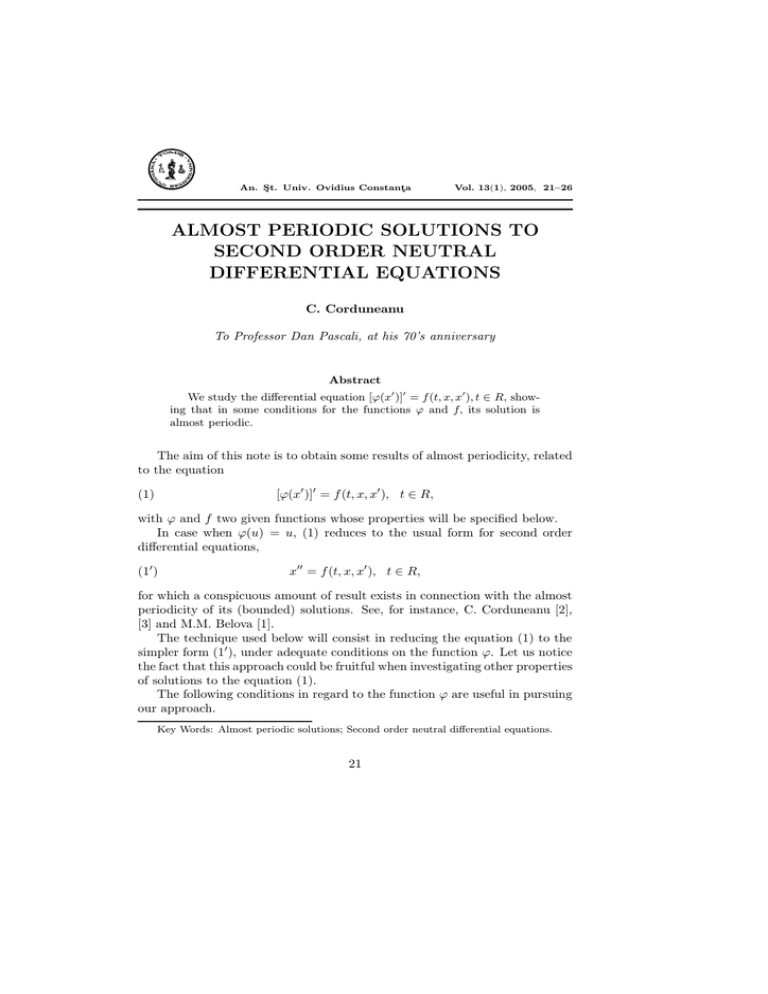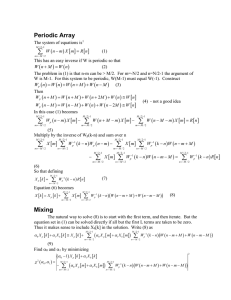ALMOST PERIODIC SOLUTIONS TO SECOND ORDER NEUTRAL DIFFERENTIAL EQUATIONS
advertisement

An. Şt. Univ. Ovidius Constanţa Vol. 13(1), 2005, 21–26 ALMOST PERIODIC SOLUTIONS TO SECOND ORDER NEUTRAL DIFFERENTIAL EQUATIONS C. Corduneanu To Professor Dan Pascali, at his 70’s anniversary Abstract We study the differential equation [ϕ(x )] = f (t, x, x ), t ∈ R, showing that in some conditions for the functions ϕ and f, its solution is almost periodic. The aim of this note is to obtain some results of almost periodicity, related to the equation [ϕ(x )] = f (t, x, x ), t ∈ R, (1) with ϕ and f two given functions whose properties will be specified below. In case when ϕ(u) = u, (1) reduces to the usual form for second order differential equations, (1 ) x = f (t, x, x ), t ∈ R, for which a conspicuous amount of result exists in connection with the almost periodicity of its (bounded) solutions. See, for instance, C. Corduneanu [2], [3] and M.M. Belova [1]. The technique used below will consist in reducing the equation (1) to the simpler form (1 ), under adequate conditions on the function ϕ. Let us notice the fact that this approach could be fruitful when investigating other properties of solutions to the equation (1). The following conditions in regard to the function ϕ are useful in pursuing our approach. Key Words: Almost periodic solutions; Second order neutral differential equations. 21 22 C. Corduneanu (a) ϕ : R → R is continuously differentiable of the second order. (b) 0 < ϕ (u) ≤ µ, u ∈ R, for some fixed µ ∈ R+ , and ϕ (u) is bounded on R. Obvious examples of functions satisfying conditions (a) and (b) are ϕ(u) = u − arctan u, or ϕ(u) = 2u + sin u. Many other choices are available. Under condition (a), equation (1) can be rewritten as x = f¯(t, x, x ), (2) with f¯(t, x, x ) = [ϕ (x )]−1 f (t, x, x ). (3) In other words, we obtrain an equation of the form (1 ). In regard to the function f¯(t, x, x ), given by (3), a key condition which is particularly used in order to secure uniqueness of a bounded solution to (2) is ∂ f¯ ≥ m > 0, ∂x (4) in the whole domain of definition of f¯, for some fixed m. This domain is usually the whole space R3 , or a slab, such as R × [−A, A] × [−B, B]. On the other hand we have ∂f ∂ f¯ = [ϕ (x )]−1 (t, x, x ), ∂x ∂x (5) and taking into account condition (b), one obtains on behalf of (4) ∂ f¯ ∂f ≥ µ−1 · ∂x ∂x (6) Let us formulate now the conditions on the function f , necessary in what follows: ∂f are continuous, and f is almost periodic (Bohr) in ∂x the first argument, uniformly in any set R × [−A, A] × R, A > 0, with respect to the second and third arguments. (c) f : R3 → R and (d) There exists λ > 0, such that 23 ALMOST PERIODIC SOLUTIONS ∂f ≥ λ. ∂x (7) Let us notice that (5), (6) and (7) imply an inequality of the form (4), i.e., (8) ∂ f¯ ≥ λµ−1 = m > 0. ∂x If we rely on the basic result in our paper [2], the following result can be stated: Theorem 1. Consider equation (1), under conditions (a), (b), (c) and (d) for the functions ϕ and f . Let x = x(t), t ∈ R, be a bounded solution of (1). Then x is also almost periodic. The proof follows from the fact that equation (1) is reduced to the form (2), with f¯ given by (3). All required conditions in [2] are satisfied by the function f¯, as it can be easily seen. In particular, the existence of ϕ (u) assures the fact that ∂f /∂x exists – a feature necessary in linearizing the equation (2). Remark 1. There is an estimate for the almost periodic solution, namely (9) sup |x(t)| ≤ t∈R M , m where M = sup |f (t, 0, 0)|, t ∈ R, and m is defined by (8). Remark 2. The conclusion of Theorem 1 can be also drawn from a result (Theorem 7) in Belova’s paper [1], but imposing an extra condition of boundedness on the derivative ∂f /∂x . Remark 3. The result of Theorem 1 must be regarded as a result of Bohr–Neugebauer type. This means, one assumes the existence of a bounded (on R) solution of the equation, before proving its almost periodicity. Regarding the existence of a bounded solution of the equation (1), we can prove it by admitting some extra condition. For the equations of the form (1 ) such results are available in the literature. We shall rely now on a result in Belova’s paper [1]. This result can be stated as follows: Consider equation (1 ), under the following assumptions: (a ) f (t, x, y) is continuous in the domain t ∈ R, |x| ≤ b, y ∈ R, and almost periodic in t, uniformly with respect to (x, y); 24 C. Corduneanu (b ) f (t, x, y) has continuous partial derivatives ∂f /∂x, ∂f /∂y, with ∂f /∂x ≥ m > 0, and |∂f /∂y| ≤ C = const. in the domain defined in (a ); (d) If M = sup |f (t, 0, 0)|, t ∈ R, then (10) M ≤ mb. Then there exists a unique solution x = x(t), t ∈ R, of (1 ), bounded on R, which is almost periodic. More precisely, the estimate (9) is valid. Going back to the neutral equation (1), we need to secure the validity of conditions (a ), (b ) and (d) for the function f¯(t, x, y) given by (3). The properties of the function ϕ in (1) will now play a key role. It is also necessary to strengthen somewhat condition (b), as follows: (b̄) 0 < λ ≤ ϕ (u) ≤ µ, for some positive λ, µ and u ∈ R. The following existence result is valid for the neutral equation (1): Theorem 2. Consider equation (1) under assumptions (a), (b̄) for the function ϕ, and (a ), (b ), (d) for the function f . Then there exists a unique almost periodic solution x = x(t), t ∈ R, of the equation (1). Proof. The only task we have now is to prove the fact that f¯(t, x, y), given by (3), verifies the conditions stipulated in Belova’s result, enunciated above. Based on conditions (a), (b̄) and (a ), we can conclude that f¯(t, x, y) is a continuous function in the domain R × [−b, b] × R, and it is almost periodic in t, uniformly with respect to (x, y). So, the first requirement is fulfilled. The condition (b ), with f¯ instead of f , is also verified. Indeed, taking into account conditions (a) and (b̄) for ϕ, there results that f¯ satisfies the continuity condition, together with the first derivatives in x and y. In regard to lower bound for ∂ f¯/∂x, we see that the inequality ∂ f¯/∂x ≥ λµ−1 = m > 0 holds true (see also (8)). The boundedness of ∂ f¯/∂y follows directly from our assumptions and the formula ∂ f¯ ∂f = [ϕ (y)]−1 − [ϕ (y)]−2 ϕ (y)f (t, x, y), ∂y ∂y obtained from (3) by differentiating in respect to y. According to condition (b̄), one has the boundedness of [ϕ (y)]−1 and [ϕ (y)]−2 ; ∂f /∂y is bounded by condition (b ), while the boundedness of f (t, x, y) is the consequence of the almost periodicity of f with respect to the first argument, uniformly in (x, y); finally, the boundedness of ϕ (y) is assured by condition (a). 25 ALMOST PERIODIC SOLUTIONS The proof of Theorem 2 is thereby complete. Remark 1. The procedure used above can be applied to investigate similar problems for first order neutral differential equations of the form (11) d ϕ(x) = f (t, x), t ∈ R. dt Remark 2. An alternate method consists in replacing equation (1) by the integro–differential equation t (12) x (t) = ϕ−1 f (s, x(s), x (s))ds + C , 0 and then proceed by fixed point principle. Let us notice that (b) implies the existence of ϕ−1 (u), u ∈ R, which turns out to be continuously differentiable. Other properties than almost periodicity could be investigated. References [1] M.M. Belova, Bounded solutions of nonlinear second order differential equations (Russian). Mat. Sbornik, 56 (98) (1962), 469-503. [2] C. Corduneanu, Almost periodic solutions to second order nonlinear differential equation (Romanian), Communicările Acad. Rom., 5 (1955), 21-26. [3] C. Corduneanu, Existence of bounded solutions on the real axis for second order differential equations (Romanian), Studii Cerc. Mat. (Iaşi), 8 (1957), 127-124. [4] C. Corduneanu Almost Periodic Equations, Chelsea (N.Y.), 1989 (Second Engl. Ed.). [5] Z. Opial Sur les intégrales bornées de l’équation u = f (t, u, u )., Annalles Polon. Math., 4 (1958), 314-423. Department of Mathematics and Informatics, Texas University, Arlington USA e-mail:cordun@uta.edu 26 C. Corduneanu

